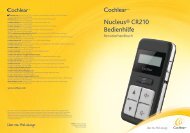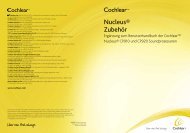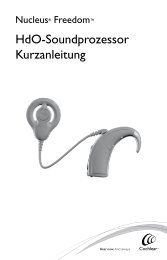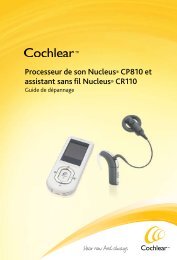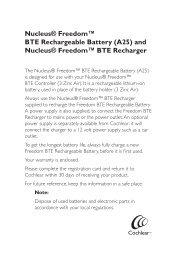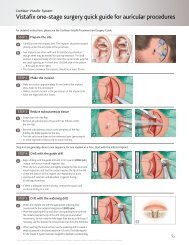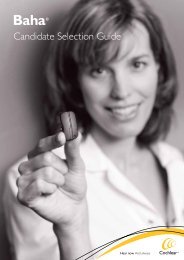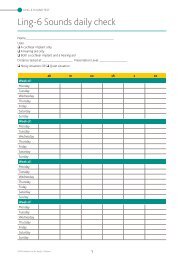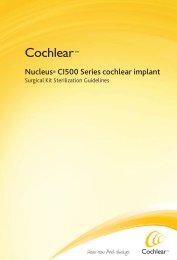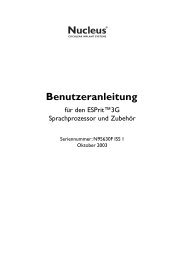609830-00 Baha BP100 User Manual_BOOK_Zone 1.indb - Cochlear
609830-00 Baha BP100 User Manual_BOOK_Zone 1.indb - Cochlear
609830-00 Baha BP100 User Manual_BOOK_Zone 1.indb - Cochlear
Create successful ePaper yourself
Turn your PDF publications into a flip-book with our unique Google optimized e-Paper software.
To use the tamper-proof battery door:<br />
See figure 10<br />
1. Make sure the screw slot is positioned vertically.<br />
2. Attach the battery door and slide it to its closed<br />
position.<br />
3. Turn the screw a quarter-turn clockwise to lock<br />
the battery door in the horizontal position.<br />
4. To unlock the battery door, turn the screw a<br />
quarter-turn counter-clockwise to vertical. The<br />
battery door can now be removed.<br />
Caution: Batteries can be harmful if<br />
swallowed. Be sure to keep your batteries<br />
out of reach of small children, those with<br />
mental challenges, and household pets. In the<br />
event a battery is accidentally swallowed, seek<br />
immediate medical attention at the nearest<br />
emergency center.<br />
General processor care<br />
Your <strong>Baha</strong> sound processor is a delicate electrical<br />
instrument. Follow these guidelines to maintain<br />
its proper working order:<br />
••<br />
If you will not be using your sound processor for<br />
any length of time, remove the battery door to<br />
let the sound processor ventilate.<br />
••<br />
If you will not be using the sound processor for a<br />
long period, remove the battery.<br />
••<br />
When not in use, turn off your sound processor<br />
and store it free from dust and dirt.<br />
••<br />
During physical activities, secure your sound<br />
processor using the safety line. If the physical<br />
activity involves contact, <strong>Cochlear</strong> recommends<br />
removing your sound processor and protecting<br />
the implant site with a sweat band or similar.<br />
••<br />
Remove your sound processor before applying<br />
hair spray or gel. If using hair dye, remove the<br />
sound processor.<br />
Using Share the Experience<br />
Family members and friends can “share the<br />
experience” of bone conduction hearing. The test<br />
rod is used by others to simulate hearing with the<br />
<strong>Baha</strong> sound processor.<br />
To use the test rod:<br />
See figure 11<br />
1 Snap the sound processor onto the test rod using<br />
the tilt technique. Hold the rod against the<br />
skull bone behind an ear.<br />
2 Plug both ears and introduce sound.<br />
To avoid feedback (whistling), the sound processor<br />
should not touch anything other than the test rod.<br />
Warnings and precautions<br />
General advice<br />
A sound processor will not restore normal<br />
hearing and will not prevent or improve a hearing<br />
impairment resulting from organic conditions.<br />
••<br />
Infrequent use of a sound processor may not<br />
permit a user to attain full benefit from it.<br />
••<br />
The use of a sound processor is only part<br />
of hearing rehabilitation and may need to<br />
be supplemented by auditory training and<br />
instructions in lip-reading.<br />
Warnings<br />
••<br />
The sound processor is a digital, electrical,<br />
medical instrument designed for specific use. As<br />
such, due care and attention must be exercised<br />
by the user at all times.<br />
••<br />
The sound processor is not waterproof!<br />
Never wear it in heavy rain, in the bath or<br />
shower!<br />
8



